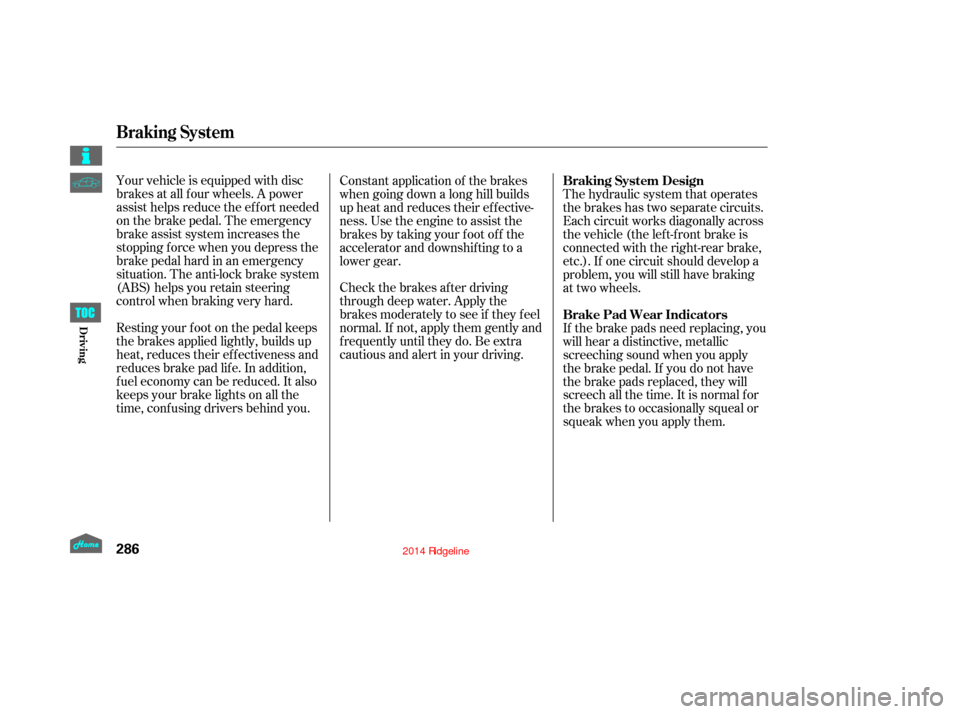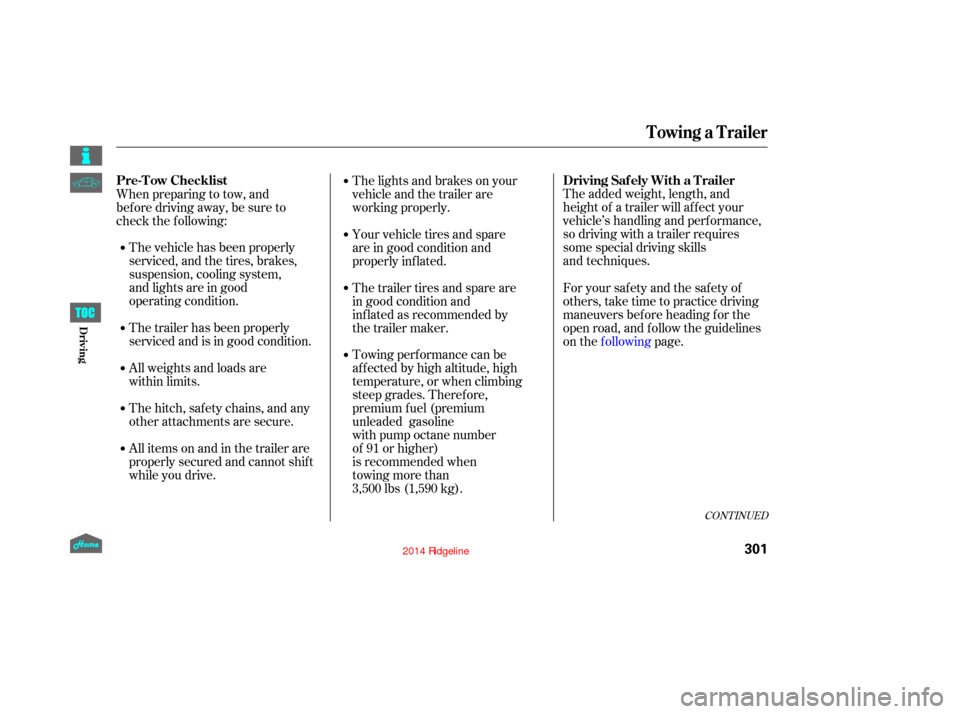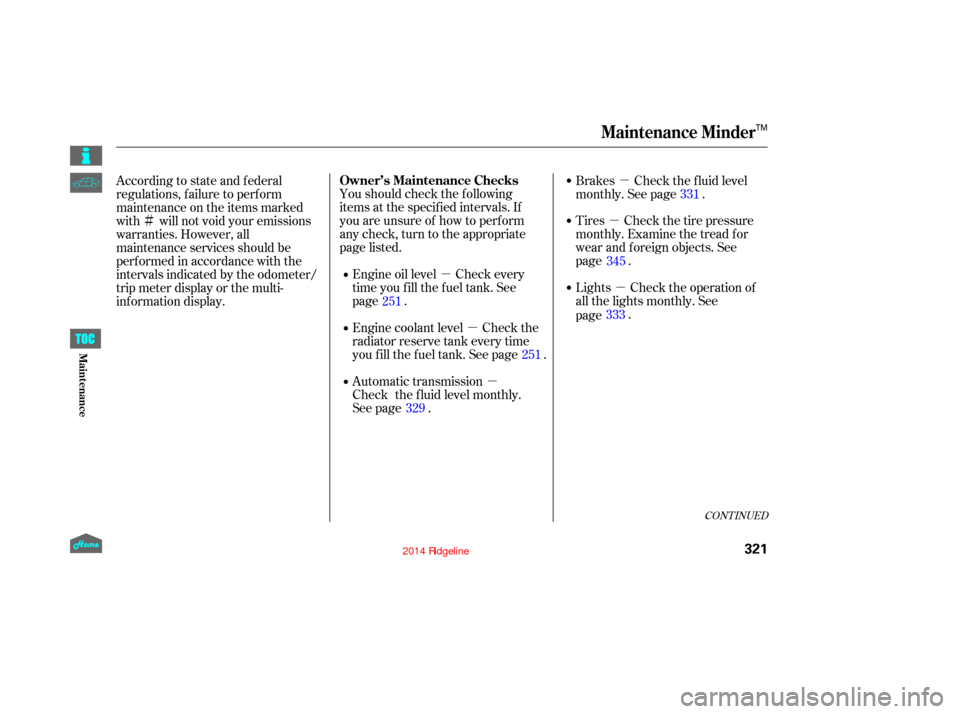Page 291 of 422

Your vehicle is equipped with disc
brakes at all f our wheels. A power
assist helps reduce the ef f ort needed
on the brake pedal. The emergency
brake assist system increases the
stopping f orce when you depress the
brake pedal hard in an emergency
situation. The anti-lock brake system
(ABS) helps you retain steering
control when braking very hard.
Resting your f oot on the pedal keeps
the brakes applied lightly, builds up
heat, reduces their ef f ectiveness and
reduces brake pad lif e. In addition,
f uel economy can be reduced. It also
keeps your brake lights on all the
time, conf using drivers behind you.Constant application of the brakes
when going down a long hill builds
up heat and reduces their ef f ective-
ness. Use the engine to assist the
brakes by taking your f oot of f the
accelerator and downshif ting to a
lower gear.
Check the brakes after driving
through deep water. Apply the
brakes moderately to see if they f eel
normal. If not, apply them gently and
f requently until they do. Be extra
cautious and alert in your driving.
The hydraulic system that operates
the brakes has two separate circuits.
Each circuit works diagonally across
the vehicle (the lef t-f ront brake is
connected with the right-rear brake,
etc.). If one circuit should develop a
problem, you will still have braking
at two wheels.
If the brake pads need replacing, you
will hear a distinctive, metallic
screeching sound when you apply
the brake pedal. If you do not have
the brake pads replaced, they will
screech all the time. It is normal f or
the brakes to occasionally squeal or
squeak when you apply them. Braking System Design
Brake Pad Wear Indicators
Braking System
286
12/08/09 16:36:50 31SJC670_293
Driving
Page 303 of 422

�´
Trailer lights and equipment must
comply with f ederal, state, province/
territory, and local regulations.
Check trailer light requirements f or
the areas where you plan to tow, and
use only equipment designed f or
your vehicle.Ref er to the above illustration f or
wiring information.
We recommend that you have your
dealer install a Honda wiring harness
and converter. This harness has
been designed f or your vehicle.
Your vehicle is equipped with a
trailer lighting connector.
Your vehicle is equipped with a
connector to install an optional trailer
lighting connector that mates with
your vehicle. You can get this
optional connector f rom your dealer. Since lighting and wiring vary with
trailer type and brand, you should
also have a qualif ied mechanic install
a suitable connector between the
vehicle and the trailer.Except RT and U.S. Sport models
On RT and U.S. Sport models
Trailer Lights
Towing a Trailer
298
TAILLIGHTS
(GREEN/BLACK) ELECTRIC BRAKE
(BROWN/WHITE) RIGHT TURN SIGNAL
AND BRAKE LIGHTS
(GREEN/RED)
GROUND
(BLACK)
B CHARGE
(GREEN)
LEFT TURN SIGNAL
AND BRAKE LIGHTS
(GREEN/RED)
BACK-UP LIGHTS
(BLUE)
12/08/09 16:38:27 31SJC670_305
Driving
Page 304 of 422
CONT INUED
Insert the connector securely into
the socket.
Hook the retaining tab on the
inner side of the lid against the
retaining tab of the connector to
prevent disconnection during
operation.
Your vehicle has a class 3 trailer
hitch as standard equipment. Make sure the connector and the
socketarefreeof dirt,moisture,
or other f oreign material.
Open the socket lid by pulling it up.
Also see page f or trailer-related
inf ormation.
The 7-pin trailer connector is needed
f or the trailer lights. To connect the
connector:
1.
2.3.
4.
295
Except RT and U.S. Sport models
Towing Equipment
Towing a Trailer
Connect ing t he T railer Connect ors
299
TRAILER HITCH
7-PIN TRAILER CONNECTOR
7-PIN TRAILER CONNECTORLID
RETAINING
TAB
SOCKET RETAINING TAB
12/08/09 16:38:37 31SJC670_306
Driving
Page 305 of 422
�´
Ref er to the above illustrations f or
wiring information.The trailer jumper harness is used to
install the controller f or the electric
trailer brakes. For more inf ormation,
see
on page . Insert the trailer brake f use into the
secondary under-hood f use box (see
page ).
296 379
Except RT and U.S. Sport models Except RT and U.S. Sport models
T railer Connect or Socket s
T railer Jumper Harness
Trailer Brakes T railer Brake Fuse
Towing a Trailer
300
7-PIN TRAILER SOCKET
SMALL
LIGHT
(GREEN)
BACK LIGHT
(YELLOW)
GROUND
(WHITE) GROUND
(BLACK)
ELECTRIC BRAKE
(BROWN/WHITE)
LEFT
TURN/
STOP
(RED) BRAKE
(20A)
(BLUE)
B
CHARGE
(BLACK)
RIGHT
TURN/
STOP
(BROWN)
ELECTRIC
BRAKE
(BLUE) BRAKE LIGHTS
(SKY BLUE)
12/08/09 16:38:45 31SJC670_307
Driving
Page 306 of 422

The added weight, length, and
height of a trailer will affect your
vehicle’s handling and performance,
so driving with a trailer requires
some special driving skills
and techniques.
The vehicle has been properly
serviced, and the tires, brakes,
suspension, cooling system,
and lights are in good
operating condition.
The trailer has been properly
serviced and is in good condition.
All weights and loads are
within limits.
Thehitch,safetychains,andany
other attachments are secure.
Allitemsonandinthetrailerare
properly secured and cannot shif t
while you drive.
When preparing to tow, and
before driving away, be sure to
check the following:
Towing performance can be
affected by high altitude, high
temperature, or when climbing
steep grades. Therefore,
premium fuel (premium
unleaded gasoline
with pump octane number
of 91 or higher)
is recommended when
towing more than
3,500 lbs (1,590 kg). The trailer tires and spare are
in good condition and
inflated as recommended by
the trailer maker. Your vehicle tires and spare
are in good condition and
properly inflated. The lights and brakes on your
vehicle and the trailer are
working properly.Foryoursafetyandthesafetyof
others,taketimetopracticedriving
maneuvers bef ore heading f or the
open road, and f ollow the guidelines
on thef ollowing page.
CONT INUED
Driving Saf ely With a T railer
Pre-T ow Checklist
Towing a Trailer
301
12/08/09 16:38:56 31SJC670_308
Driving
Page 314 of 422

This section explains why it is
important to keep your vehicle well
maintained and how to f ollow basic
maintenance saf ety precautions.
This section also includes
instructions on how to read the
Maintenance Minder messages on
the inf ormation display or multi-
inf ormation display (depending on
the model), and instructions for
simple maintenance tasks you may
want to take care of yourself.U.S. Vehicles:
If you have the skills and tools to
perf orm more complex maintenance
tasks on your vehicle, you may want
to purchase the service manual. See
page f or inf ormation on how to
obtain a copy, or see your dealer. ......................
Maintenance Saf ety .310
.................
Maintenance Minder . 311
..............................
Fluid Locations .323
........................
Adding Engine Oil .324
Changing the Engine Oil and ...........................................
Filter .325
..............................
Engine Coolant .327
....................
Windshield Washers .328
....
Automatic Transmission Fluid . 329
....................................
Brake Fluid .331
....................
Power Steering Fluid . 332
....................................
Timing Belt .333
.............................................
Lights .333
................
Cleaning the Seat Belts . 341
.....................................
Floor Mats .342
..................
Dust and Pollen Filter . 342
.................................
Wiper Blades .343
...........................................
Wheels .345
...............................................
Tires .345
...................
Checking the Battery . 353
.............................
Vehicle Storage .354
..................................
Interior Care .355
405
Maintenance
Maintenance, replacement, or
repair of emissions control
devices and systems may
be done by any automotive
repair establishment or
individual using parts that are
‘‘certif ied’’ to EPA standards.
309
TM
12/08/09 16:40:00 31SJC670_316
Page 326 of 422

�µ�µ�µ �µ
�µ
�µ
�Ì
Youshouldcheckthefollowing
items at the specif ied intervals. If
you are unsure of how to perf orm
any check, turn to the appropriate
page listed.
Engine oil level Check every
time you fill the fuel tank. See
page .
Engine coolant level Check the
radiator reserve tank every time
you f ill the f uel tank. See page .
Automatic transmission
Check the fluid level monthly.
See page . Brakes Check the f luid level
monthly. See page .
Tires Check the tire pressure
monthly. Examine the tread for
wear and foreign objects. See
page
.
Lights Check the operation of
all the lights monthly. See
page .
According to state and federal
regulations, f ailure to perf orm
maintenance on the items marked
with will not void your emissions
warranties. However, all
maintenance services should be
perf ormed in accordance with the
intervals indicated by the odometer/
trip meter display or the multi-
inf ormation display.
251
251
329 331
345
333
CONT INUED
Maintenance Minder
Owner’s Maintenance Checks
321
TM
12/08/09 16:41:32 31SJC670_328
Maint enance
Page 338 of 422

�µ�µTheheadlightswereproperlyaimed
when your vehicle was new. If you
regularly carry heavy items on the
pickup bed or pull a trailer,
readjustment may be required.
Adjustmentsshouldbedonebyyour
dealer or other qualif ied technician.
Your vehicle has halogen headlight
bulbs. When replacing a bulb,
handle it by its base, and protect the
glass from contact with your skin or
hard objects. If you touch the glass,
clean it with denatured alcohol and a
clean cloth.
The timing belt should be replaced
at the intervals shown in the
Maintenance Minder schedule.
Replace the timing belt every 60,000
miles (100,000 km) if you regularly
drive your vehicle in any of the
f ollowing conditions:
In very high temperatures
(over 110°F, 43°C).
In very low temperatures
(under 20°F, 29°C).
Frequently towing a trailer.
CONT INUED
Headlight A iming Replacing a Headlight Bulb
Timing Belt
T iming Belt, L ights
333
TM
Halogen headlight bulbs get very hot
when lit. Oil, perspiration, or a scratch
on the glass can cause the bulb to
overheat and shatter.
12/08/09 16:43:02 31SJC670_340
Maint enance